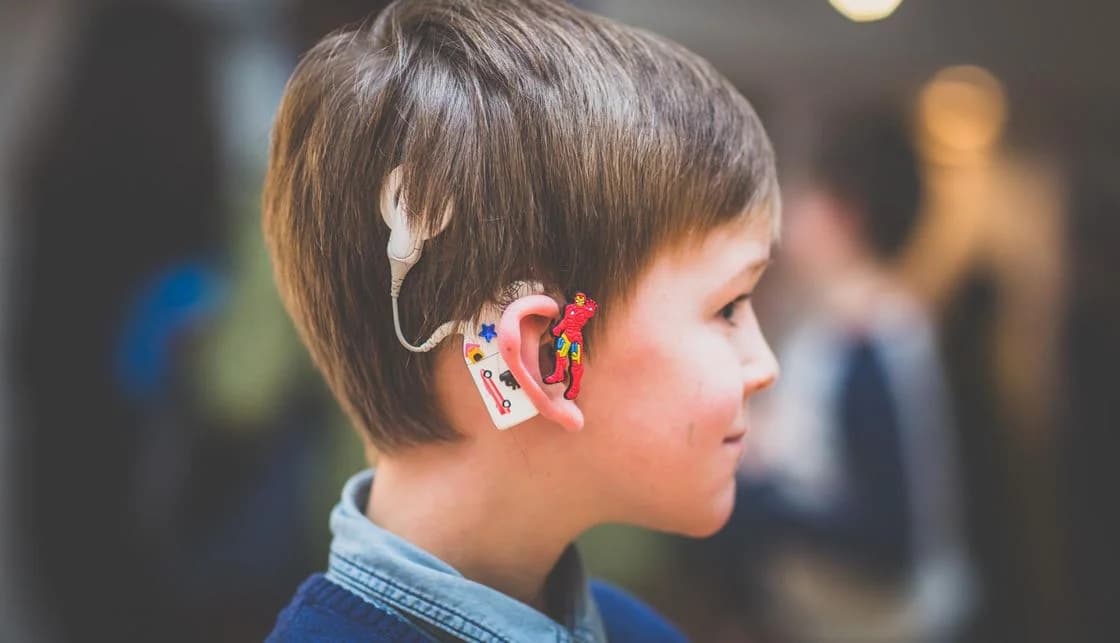A cochlear implant is an electronic device that improves hearing. This device is an option for those with severe hearing loss from inner ear damage. While hearing aids amplify sounds, a cochlear implant bypasses damaged portions of the ear to deliver sound signals to the hearing nerve. The surgery for placing the cochlear implant inside the ear is done under general anesthesia. Afterward, patients must visit their audiologist in a few weeks to have the cochlear implant activated and programmed.
What are cochlear implants?
A cochlear implant is an electronic device that reduces hearing loss. Although they can’t restore hearing, they can improve your ability to understand speech and hear other sounds.
What are the types of cochlear implants?
Depending on the location of the external sound processor, cochlear implants differ. This processor may be:
Behind your ear
Attached to your clothes
On your scalp

Who Is a Cochlear Implant Candidate?
Severe hearing loss affects your ability to communicate with others
Hearing loss that does not improve with the use of hearing aids
Those without medical conditions increase the risks of getting cochlear implants
Realistic expectations about how cochlear implants can improve your hearing
Willingness to participate in rehabilitation required to learn how to effectively use the device
You should also keep in mind that a CT scan or MRI is needed to determine your ear anatomy & decide if you are eligible for a cochlear implant.
How is a cochlear implant inserted?
While under anesthesia, your surgeon will make a small incision behind your ear to place the internal processor in a pocket between muscle and bone. Drilling a small hole, the surgeon gains access to the inner ear and places the electrodes inside the cochlea. This procedure is about 2 hours long. Afterward, in 3-4 weeks, your cochlear implant will be activated by your audiologist. This will start electrical stimulation and a new hearing experience for the patient.
How cochlear implants work
Generally hearing starts with sounds that travel from your outer ear and your middle ear to your inner ear. In your inner ear, your cochlea supports hearing. Part of your cochlea contains very tiny hair cells. These hair cells connect with your hearing nerve. When sound hits your cochlea an electrical signal is sparked which will be carried to your brain’s temporal lobe. Your temporal lobe perceives the electrical signal as sound that your brain interprets as speech, music, or other noise.
Cochlear implants essentially bypass your inner ear structure, creating a new pathway for sounds to make their way to your brain. It works like this:
You wear a sound processer that sorts the sounds coming into your outer ear
The sound processor sends signals to a transmitter attached to your scalp with a magnet
The transmitter converts the signals into electric impulses that it sends to electrodes placed in your cochlea
The electrodes in your cochlea collect the impulses, sending them on to hearing nerves
The hearing nerves let your brain know sounds are coming in

Types of Cochlear Implants
Cochlear implants are available in different sizes, weights, number of electrodes, and features. A child can use the same implants as adults because the size of internal ear structures does not change with age. An appointment with an audiologist is scheduled before surgery to help you learn about the options and choose the implant that meets your needs.
Cochlear Implant Activation and Programming
After the surgery, as your inner ear has healed enough, you’ll return to the audiologist. Then they will program the cochlear implant and show you how to use the external processor on the ear. To get your nerves and brain used to hear again. During the 4-6 weeks of surgery, you’ll meet with your surgeon several times. With the help of your audiologist and auditory rehabilitation therapist, you’ll develop a plan to train your brain to interpret sounds in a way that fits with your lifestyle. Afterward, you’ll need to have programming appointments every 6-12 months during the life of the implant.
What does it sound like after cochlear implant surgery?
This is a difficult question to answer because perceived sound quality varies for each person. Those with cochlear implants usually describe sounds as “mechanical,” “robotic,” “cartoonish” and “like people are talking with marbles in their mouth.” Some patients experience only sensations when the implant is first turned on. It will take a while for you to get used to a cochlear implant. Most patients notice improving sound quality during the first three to 12 months.

Although most patients can distinguish soft, medium, or loud noises, even identify common sounds such as doorbells, phones, and footsteps. Some can even use the telephone and enjoy music and television. Difficulty will probably remain when listening in large groups or noisy situations that are challenging even for people with full hearing in both ears. Progress is slower for children, who need to learn language through hearing with the cochlear implant. Having a cochlear implant can make it easier to lip read even if the hearing does not improve enough so that speech can be understood.
Conclusion
In conclusion, cochlear implants are electronic devices that significantly improve the ability to understand speech and hear sounds for individuals with severe hearing loss. There are several types of cochlear implants, each differing based on the location of the external sound processor. The processor may be located behind the ear, attached to clothes, or on the scalp1. Major manufacturers of cochlear implants include Cochlear, Advanced Bionics, and Medel. These implants work by creating a new pathway for sounds to reach the brain, bypassing the damaged inner ear structure.
Read more: